Investigation of Cavitation Bubble Dynamics Considering Pressure Fluctuation Induced by Slap Forces
Abstract
:1. Introduction
2. Theoretical Basis
3. Results and Discussion
3.1. Influence of Bubble Position and Initial Radius on Bubble Evolution
3.2. Influence of Negative Pressure Period
3.3. Shock Pressure during Bubble Collapse
4. Conclusions
Author Contributions
Funding
Institutional Review Board Statement
Informed Consent Statement
Data Availability Statement
Conflicts of Interest
References
- Williams, P.R.; Williams, P.M.; Brown, S.W.J. A technique for studying liquid jets formed by cavitation bubble collapse under shockwaves, near a free surface. J. Non Newton. Fluid Mech. 1997, 72, 101–110. [Google Scholar] [CrossRef]
- Lin, J.; Wang, Z.; Cheng, J.; Kang, M.; Fu, X.; Hong, S. Evaluation of cavitation erosion resistance of arc-sprayed Fe-based amorphous/nanocrystalline coatings in NaCl solution. Results Phys. 2019, 12, 597–602. [Google Scholar] [CrossRef]
- Rayleigh, L., VIII. On the pressure developed in a liquid during the collapse of a spherical cavity. Lond. Edinb. Dublin Philos. Mag. J. Sci. 1917, 34, 94–98. [Google Scholar] [CrossRef]
- Plesset, M.S. The dynamics of cavitation bubbles. J. Appl. Mech. 1949, 16, 277–282. [Google Scholar] [CrossRef]
- Noltingk, B.E.; Neppiras, E.A. Cavitation produced by ultrasonics. Proc. Phys. Soc. B 1950, 63, 674. [Google Scholar] [CrossRef]
- Franc, J.P.; Michel, J.M. Fundamentals of cavitation. In Fluid Mechanics and Its Applications; Springer: Amsterdam, The Netherlands, 2004; Volume 76, pp. 1–46. [Google Scholar]
- Lv, L.; Zhang, Y.; Zhang, Y.; Zhang, Y. Experimental investigations of the particle motions induced by a laser-generated cavitation bubble. Ultrason. Sonochem. 2019, 56, 63–76. [Google Scholar] [CrossRef] [PubMed]
- Ren, X.; He, H.; Tong, Y.; Ren, Y.; Yuan, S.; Liu, R.; Zuo, C.; Wu, K.; Sui, S.; Wang, D. Experimental investigation on dynamic characteristics and strengthening mechanism of laser-induced cavitation bubbles. Ultrason. Sonochem. 2016, 32, 218–223. [Google Scholar] [CrossRef] [PubMed]
- Cheng, F.; Ji, W.; Qian, C.; Xu, J. Cavitation bubbles dynamics and cavitation erosion in water jet. Results Phys. 2018, 10, 1585–1593. [Google Scholar] [CrossRef]
- Lauterborn, W.; Bolle, H. Experimental investigations of cavitation-bubble collapse in the neighbourhood of a solid boundary. J. Fluid Mech. 1975, 72, 391–399. [Google Scholar] [CrossRef]
- Joshi, S.; Franc, J.P.; Ghigliotti, G.; Fivel, M. Bubble collapse induced cavitation erosion: Plastic strain and energy dissipation investigations. J. Mech. Phys. Solids 2019, 134, 103749. [Google Scholar] [CrossRef]
- Blake, J.R.; Robinson, P.B.; Shima, A.; Tomita, Y. Interaction of two cavitation bubbles with a rigid boundary. J. Fluid Mech. 1993, 255, 707–721. [Google Scholar] [CrossRef]
- Stanley, C.; Barber, T.; Rosengarten, G. Re-entrant jet mechanism for periodic cavitation shedding in a cylindrical orifice. Int. J. Heat Fluid Flow 2014, 50, 169–176. [Google Scholar] [CrossRef]
- Thomas, J.; Ibrahim, M.; Robin, O.; Lawrence, A.; William, C.; Ronald, A. The acoustic emissions from single-bubble sonoluminescence. J. Acoust. Soc. Am. 1998, 103, 1377–1382. [Google Scholar]
- Kyuichi, Y.; Toru, T.; Manickam, S.; Yasuo, I. Theoretical study of single bubble sonochemistry. J. Chem. Phys. 2005, 122, 224706. [Google Scholar]
- Yamashita, T.; Ando, K. Low-intensity ultrasound induced cavitation and streaming in oxygen-supersaturated water: Role of cavitation bubbles as physical cleaning agents. Ultrason. Sonochem. 2019, 52, 268–279. [Google Scholar] [CrossRef]
- Tzanakis, I.; Eskin, D.G.; Georgoulas, A.; Fytanidis, D.K. Incubation pit analysis and calculation of the hydrodynamic impact pressure from the implosion of an acoustic cavitation bubble. Ultrason. Sonochem. 2014, 21, 866–878. [Google Scholar] [CrossRef]
- Yonezawa, T.; Senda, J.; Okubo, M.; Fujimoto, H.; Miki, H. Experimental analysis on the behavior of cavitation bubbles at cylinder liner erosion in diesel engines. J. Mar. Eng. Soc. Jpn. 1985, 20, 361–369. [Google Scholar] [CrossRef]
- Yonezawa, T.; Senda, J.; Saitou, M.; Yoshiki, K.; Fujimoto, H.; Miki, H. Analysis of cavitation on cylinder liner and cylinder block. J. Mar. Eng. Soc. Jpn. 1988, 23, 38–46. [Google Scholar] [CrossRef]
- Shima, A.; Tomita, Y. The behavior of a spherical bubble near a solid wall in a compressible liquid. Arch. Appl. Mech. 1981, 51, 243–255. [Google Scholar]
- Kozuka, T.; Hatanaka, S.; Yasui, K.; Tuziuti, T.; Mitome, H. Simultaneous Observation of Motion and Size of a Sonoluminescing Bubble (Short Note). Jpn. J. Appl. Phys. Part 1 Regul. Pap. Short Notes Rev. Pap. 2002, 41, 3248–3249. [Google Scholar] [CrossRef]
- Wang, X.; Zheng, Z.; Chen, Y.; Li, Y. Theoretical analysis of engine coolant cavitation with different additives based on ultrasonic induced bubble dynamics. Results Phys. 2019, 15, 102528. [Google Scholar] [CrossRef]
- Knapp, R.T.; Daily, J.W.; Hammitt, F.G. Cavitation; McGraw-Hill: New York, NY, USA, 1970. [Google Scholar]
- Lauterborn, W.; Vogel, A. Shock Wave Emission by Laser Generated Bubbles. In Bubble Dynamics & Shock Waves; Delale, C.F., Ed.; Springer: Berlin/Heidelberg, Germany, 2013; pp. 67–103. [Google Scholar]


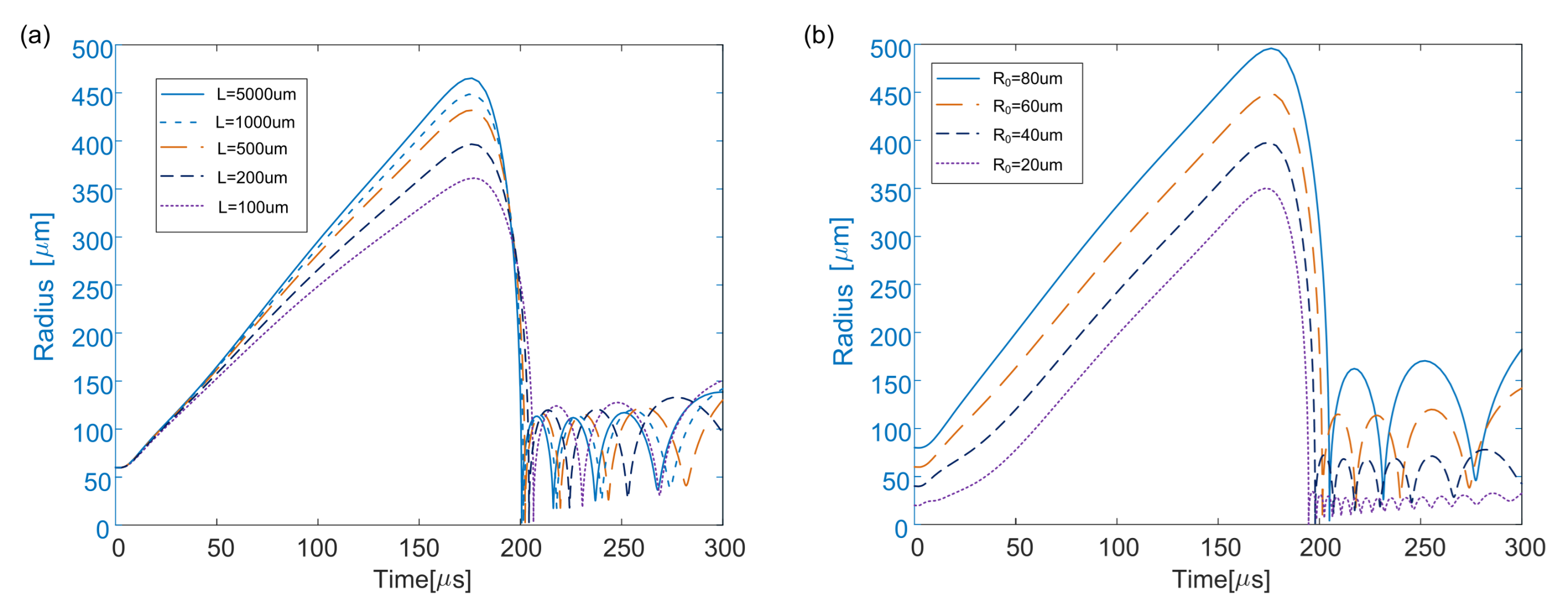



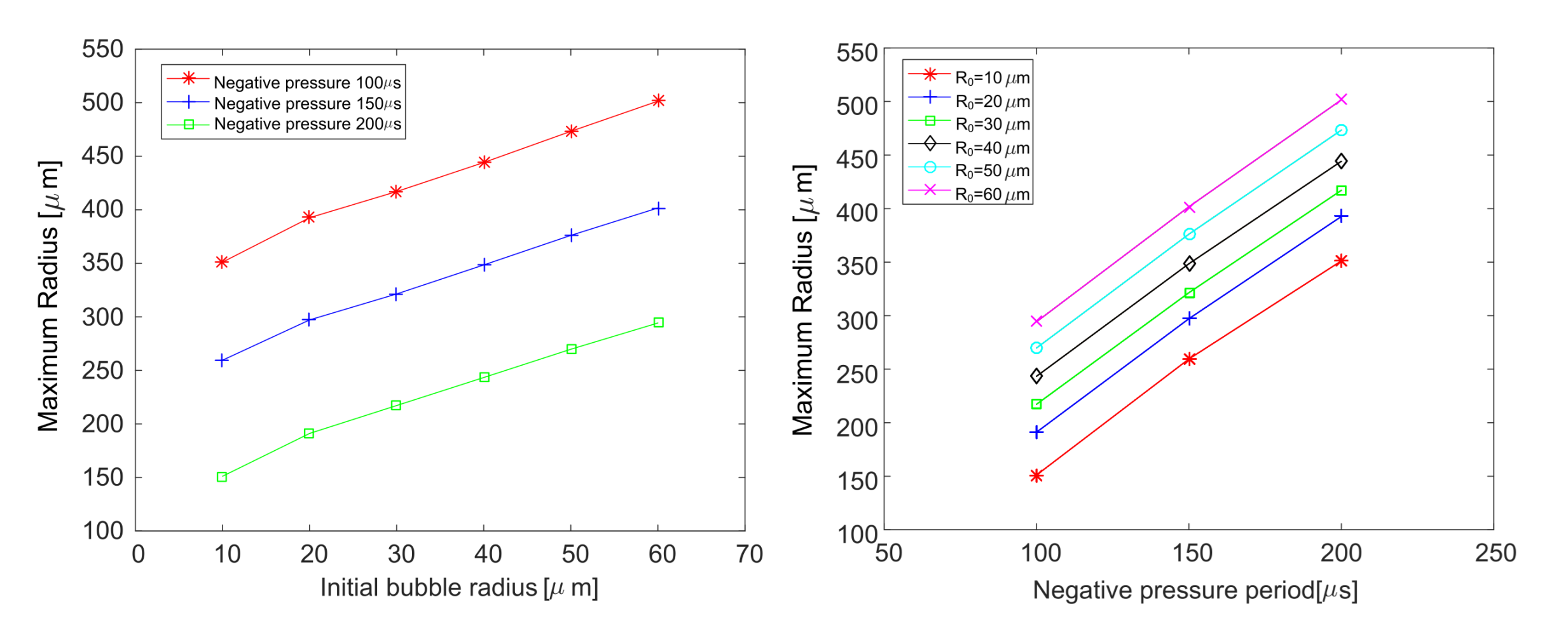
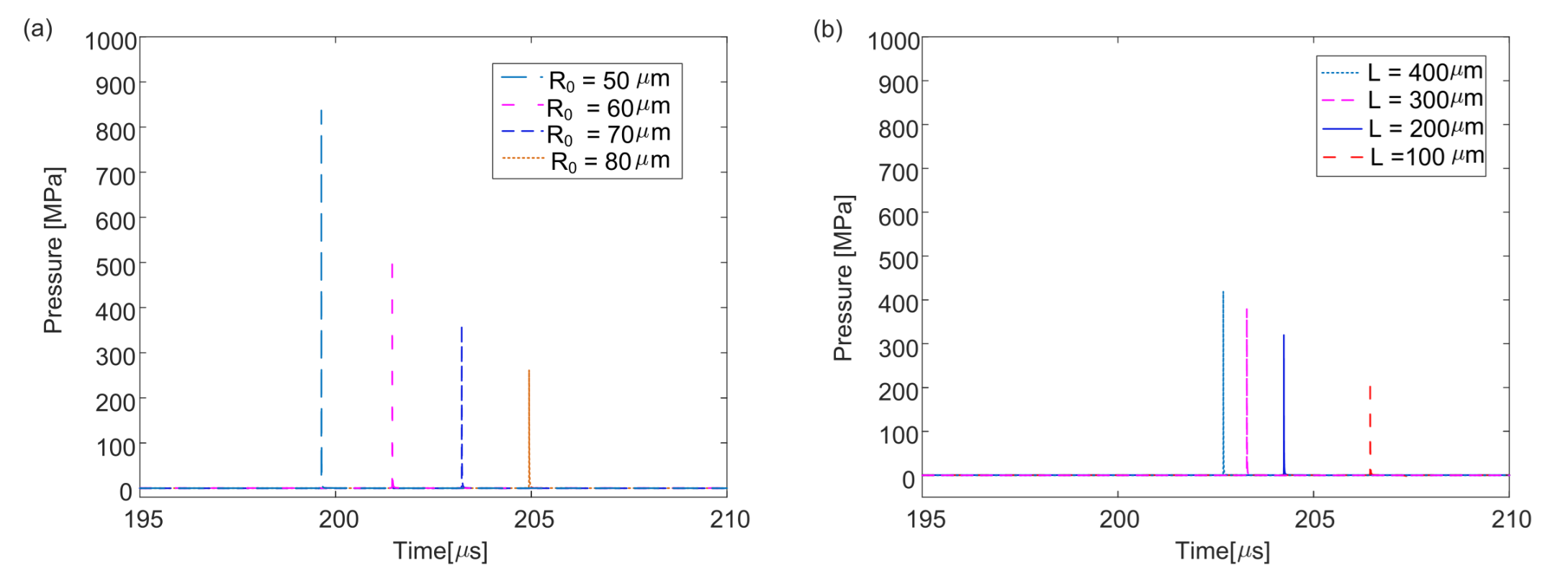
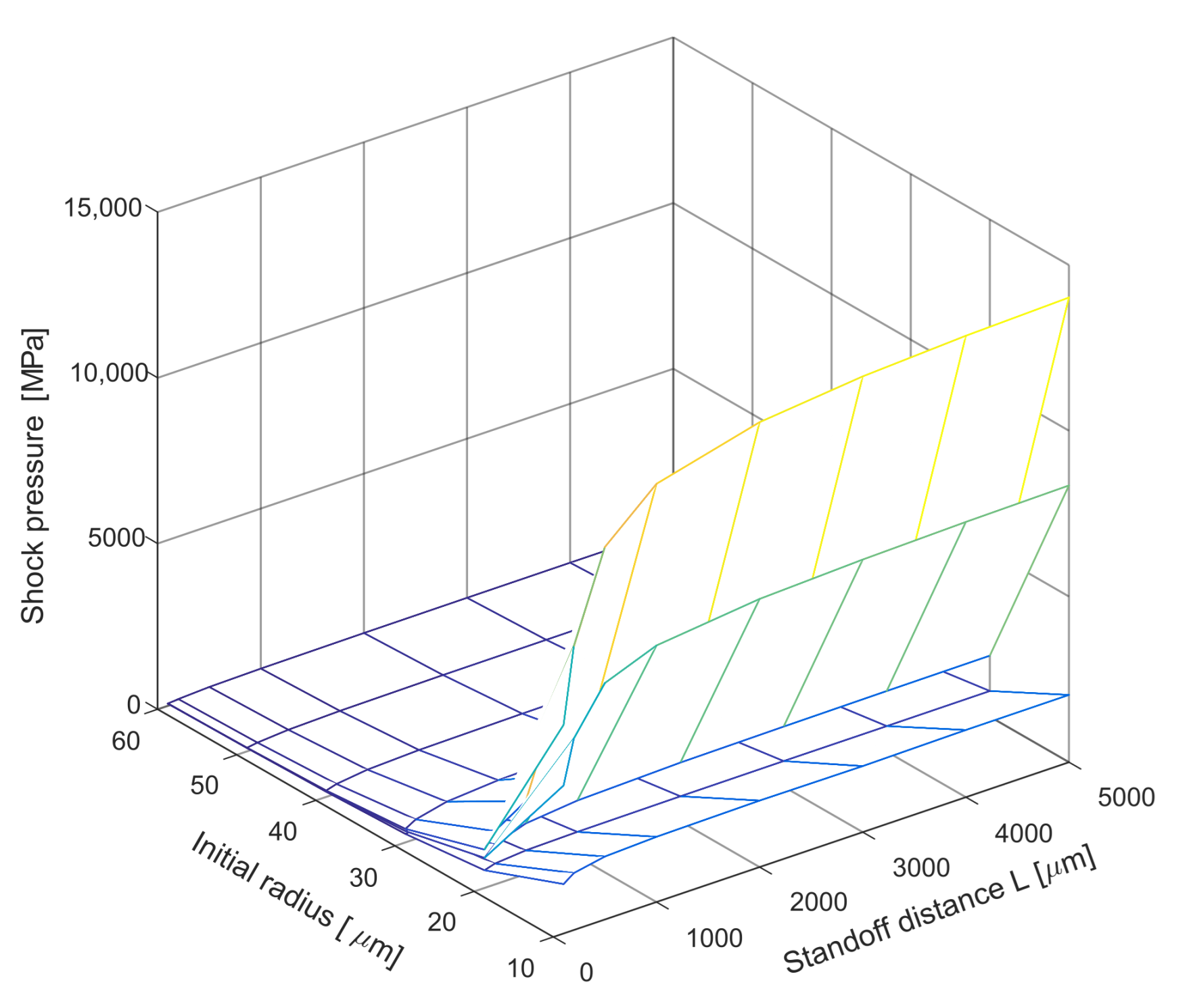
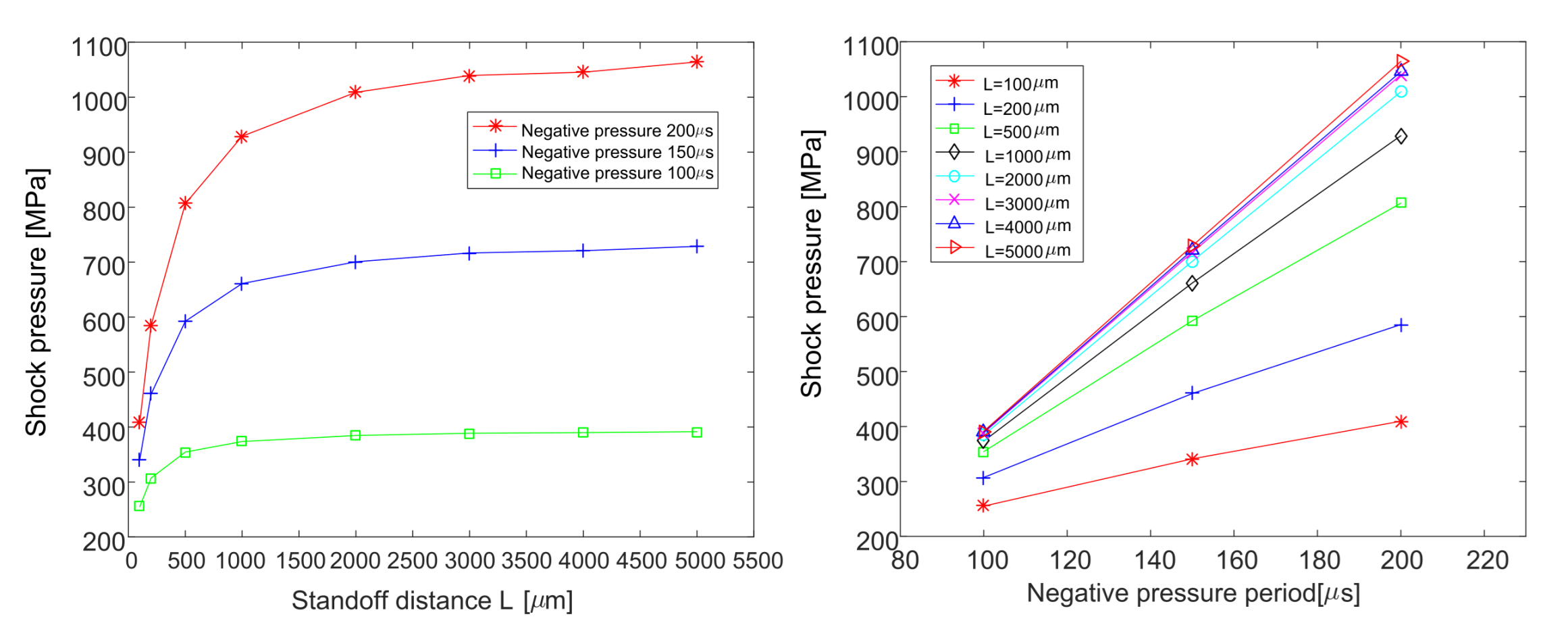
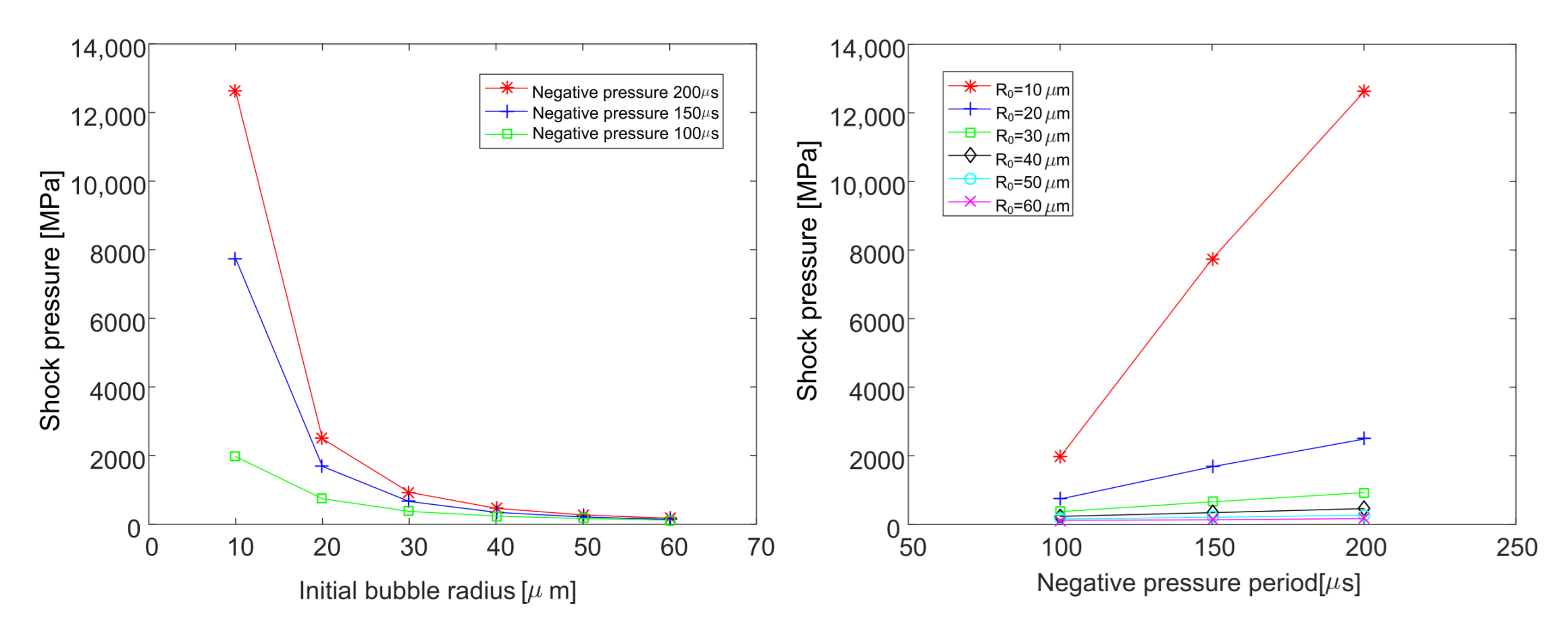
Publisher’s Note: MDPI stays neutral with regard to jurisdictional claims in published maps and institutional affiliations. |
© 2021 by the authors. Licensee MDPI, Basel, Switzerland. This article is an open access article distributed under the terms and conditions of the Creative Commons Attribution (CC BY) license (https://creativecommons.org/licenses/by/4.0/).
Share and Cite
Wang, X.; Zhou, S.; Shan, Z.; Yin, M. Investigation of Cavitation Bubble Dynamics Considering Pressure Fluctuation Induced by Slap Forces. Mathematics 2021, 9, 2064. https://doi.org/10.3390/math9172064
Wang X, Zhou S, Shan Z, Yin M. Investigation of Cavitation Bubble Dynamics Considering Pressure Fluctuation Induced by Slap Forces. Mathematics. 2021; 9(17):2064. https://doi.org/10.3390/math9172064
Chicago/Turabian StyleWang, Xiaoyu, Shenghao Zhou, Zumeng Shan, and Mingang Yin. 2021. "Investigation of Cavitation Bubble Dynamics Considering Pressure Fluctuation Induced by Slap Forces" Mathematics 9, no. 17: 2064. https://doi.org/10.3390/math9172064
APA StyleWang, X., Zhou, S., Shan, Z., & Yin, M. (2021). Investigation of Cavitation Bubble Dynamics Considering Pressure Fluctuation Induced by Slap Forces. Mathematics, 9(17), 2064. https://doi.org/10.3390/math9172064





